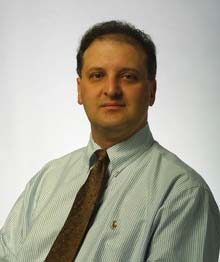Discovery of Brain Disorder Gene Paves Way for Genetic Test

Douglas A. Marchuk, PhD <br>Credit: Duke University Medical Center
Duke University Medical Center researchers have identified the second of three genes that can each independently cause the disorder known as cerebral cavernous malformations (CCM), which is characterized by mulberry-like clusters of blood vessels in the brain. The finding paves the way for a new genetic test for the rare, familial disease, which typically lies dormant in patients for decades before its potentially devastating symptoms appear, said the researchers.
The vessel lesions in the brain can cause seizures, severe headaches, hemorrhagic stroke and neurological deficits. Affected individuals have a 50 percent chance of passing the disease on to their children.
“People with this mutation are at great risk for developing blood vessel lesions in the brain and their associated symptoms, as are their future children,” said Duke geneticist Douglas Marchuk, Ph.D., who led the study. “This is an example where genetic testing can make a tremendous impact on the care these families receive.” Physicians currently diagnose patients only when lesions are found on an MRI scan after symptoms develop.
The team reports its findings in the December 2003 issue of The American Journal of Human Genetics. The work was supported by the National Institutes of Health and the American Heart Association.
Earlier research into the genetic basis of CCM found that three separate genes in the human genome can, when mutated, cause the disease in different families. In 1999, Marchuk’s team and a second group in France independently discovered the first of these genes, called KRIT1.
Although KRIT1’s function remains unknown, the Duke team more recently found that the protein binds a second protein related to a family of receptors called integrins. Integrins are responsible for cells’ ability to respond appropriately to their external environments.
That clue led the team to search the second genetic region linked to CCM for aberrant genes resembling KRIT1’s known protein binding partner.
Nine families with the “type 2” form of CCM harbored eight different mutations in a single gene bearing structural similarity to KRIT1’s partner, the researchers now report. They call the newly identified CCM gene “malcavernin.”
“While some individuals with CCM have essentially no symptoms, others suffer profound effects on a day-to-day basis,” said genetic counselor Tracey Leedom also of Duke. “The identification of this gene will allow more people with a familial history of the disease to be tested early. If they are found to have the gene, physicians can then conduct an MRI and begin monitoring them carefully for any symptoms.”
Lesions can be surgically removed from the brain in some patients, she added. For others, only the symptoms can be treated.
The team will next seek out the last of the genes known to cause CCM, Marchuk said. The investigators have also begun exploring the biological basis of CCM in mice with the disease.
Others at Duke that contributed to the research include lead author Christina Liquori, Ph.D., Elizabeth Huang, Jon Zawistowski, Fiyinfolu Balogun, Lori Hughes and Nicholas Plummer, Ph.D. Additional collaborators include Michel Berg, M.D., at the University of Rochester Medical Center; Adrian Siegel, M.D., at the University Hospital Zurich; T’Prien Stoffer and Eric Johnson, Ph.D., at the Barrow Neurological Institute in Phoenix; Dominique Verlaan, Ph.D., and Guy Rouleau, M.D., at Montreal General Hospital; Milena Cannella, M.D., Vittorio Maglione, M.D., and Ferdinando Squitieri, M.D., at Instituto di Ricovero e Cura a Carattere Scientifico in Italy; and Louis Ptacek, M.D., at the University of California, San Francisco.
Media Contact
More Information:
http://www.dukemednews.org/news/article.php?id=7300All latest news from the category: Health and Medicine
This subject area encompasses research and studies in the field of human medicine.
Among the wide-ranging list of topics covered here are anesthesiology, anatomy, surgery, human genetics, hygiene and environmental medicine, internal medicine, neurology, pharmacology, physiology, urology and dental medicine.
Newest articles

NASA: Mystery of life’s handedness deepens
The mystery of why life uses molecules with specific orientations has deepened with a NASA-funded discovery that RNA — a key molecule thought to have potentially held the instructions for…

What are the effects of historic lithium mining on water quality?
Study reveals low levels of common contaminants but high levels of other elements in waters associated with an abandoned lithium mine. Lithium ore and mining waste from a historic lithium…

Quantum-inspired design boosts efficiency of heat-to-electricity conversion
Rice engineers take unconventional route to improving thermophotovoltaic systems. Researchers at Rice University have found a new way to improve a key element of thermophotovoltaic (TPV) systems, which convert heat…



